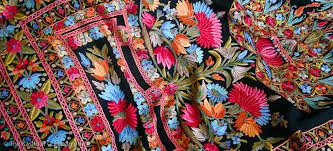The tradition of weaving in Kashmir dates back over a thousand years, and the artistry of Kashmiri weavers remains a vital part of the region’s identity and economy. From the intricate patterns of Pashmina Shawls to the richly textured Kashmir rugs, the weavers of Kashmir have preserved a craft that combines skill, creativity and earning worldwide. The origin of weaving in Kashmir can be traced to the ancient period when the region was influenced by both Persian and Central Asian cultures. Early evidence of weaving dates back to the 3rd Century CE, but it was during the Mughal period in the 16th century that the craft truly flourished. Emperors such as Akbar, Jahangir and Shah Jahan patronised the art, and under their rule, Kashmir became a hub for textile production, particularly in the form of fine woolen shawls.
Kashmiri weavers use a variety of materials, such as Wool, Silk and Pashmina. Wool from the Pashmina goat is particularly prized for its softness and warmth. The weaving is typically done on traditional wooden looms, some of which are over a century old. Kashmiri textiles are known for their intricate designs, often inspired by nature floral motifs, paisleys and geometric patterns which are common. Kani weaving, which is used to create detailed motifs, is one of the oldest techniques still practiced today. This process is time-consuming and requires extreme patience. The dyeing process is another critical aspect of Kashmiri weaving. The colours used in Kashmiri textiles are traditionally derived from natural sources such as flowers, plants and minerals. The spinning of the wool, particularly for Pashmina, is also done by hand, requiring precision and care to ensure the finest yarn. As mentioned, Pashmina shawls are among the most famous Kashmiri textiles. These shawls are hand woven with the fine wool of the Chyangra goat, producing a soft, luxurious fabric that is both warm and light. Some Pashmina shawls are embroidered with sozni or kashida stitches. Kashmir is also renowned for its hand-woven carpets. The Kalamkari technique, used in carpet weaving, involves creating motifs that tell a story or depict scenes from nature. These shawls are often made of silk or a combination of silk and wool and they are highly valued for their fine detail and labor-intensive production process. In addition to Pashmina and Carpets, Kashmiri weavers also produce namda and suff, felted wool products. Namda is a type of felted wool mat, often used as floor coverings, while suff is a thicker felt used for creating blankets or other textiles.
Despite the global recognition of Kashmiri textiles, the weavers of Kashmir face numerous challenges. One of the major issues is the competition from machine-made textiles, which are produced at a much faster pace and at a lower cost. While machine-made products can mimic the designs and patterns of traditional Kashmiri textiles, they cannot replicate the fine craftsmanship and quality that handwoven textiles offer. The rise of synthetic fibers has also affected the demand for traditional wool and Pashmina products. Moreover, the ongoing socio-economic challenges in Kashmir have made it difficult for weavers to sustain their livelihoods. Many weavers have migrated to other regions in search of better opportunities and the younger generation, often more inclined towards modern professions, is less interested in continuing the craft. In response to these challenges, various initiatives have been launched to preserve and promote Kashmiri weaving. Non-Governmental Organisations, Government programs and Private enterprises are working to provide weavers with access to better tools, fair wages and training in modern marketing techniques. Moreover, efforts are being made to protect the Pashmina industry through certifications such as the Pashmina Wool Certification that ensures the authenticity of products and prevents exploitation. In recent years, there has also been a surge in interest from international buyers and designers, who are keen to incorporate Kashmiri textiles into high-end fashion and interior design. This global interest has provided an economic boost to local weavers, encouraging them to continue their craft.


